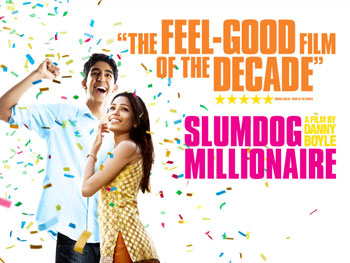Jai Ho! That’s the tune that’s currently making music to everyone’s ears. With Danny Boyle’s Slumdog Millionaire bagging 8 Oscars at the Academy Awards — besides 4 Golden Globes and 7 BAFTAs — this year, Indian cinema and music suddenly seem to take centre stage. Even slums — that one once often chose to, at best, avoid — have now come into focus. Well, for those with an Indian sensibility, such a turn of events does not seem to surprise… except for those who choose to remain in their anticipated disbeliefs.

- Slumdog Millionaire
Slumdog Millionaire is a typical rags-to-riches story of Jamal Malik (Dev Patel), a street kid from the slums of Dharavi in Mumbai, who goes on to win two crore rupees in the game show, Who Wants to be a Millionaire? Yet, it’s not so much the money that makes Jamal feel like a millionaire as much as him being united with his childhood sweetheart Latika (Freida Pinto). In traversing through its plot, the film moves through the ugly side of Indian slums, brothels, crime and poverty.
While the movie’s cinematography, music score and direction are excellent, the film’s subject still evokes mixed responses. Did the movie deserve the success it has enjoyed? Did it deserve to win 8 Oscars? Aren’t there better movies made in India? Isn’t India being consumed through the eyes of an outsider? Isn’t this hard selling India’s poverty?
Last year, when Aravind Adiga’s novel, The White Tiger, won the Man Booker Prize, similar questions were asked. The plot of the novel centres around Balram Halwai, a rickshaw puller’s son, who uses opportunity mixed with chicanery to establish himself as a successful entrepreneur in Bangalore, a symbol of emerging India. That the novel was addressed in the form of a series of letters to Wen Jiabao, the Premier of the State Council of the People’s Republic of China proved even more insulting to the urban Indian. How could we wash our “dirty linen” in front of our economic archrival?
Admittedly, the use of the word “slumdog” for the title of the film is deplorable. Danny Boyle, Loveleen Tandan or Simon Beaufoy should have refrained from hurting the sentiments of the very people whose story and condition they sought to highlight. One ought to realise that even slum dwellers are human beings! Even they have a sense of self-worth and deserve dignity and respect.
With due respect to Salman Rushdie who has “problems with the storyline” of the movie and Amitabh Bachchan who fears that Slumdog Millionaire “projects India as Third World dirty under belly developing nation”, one should not forget the realism contained in this film. Much to the chagrin of the urban Indian mindset, India remains a Third World country. In spite of encouraging growth rates and GDPs, India seems to be moving around in its own karmic circles. Well, I do not mean to suggest that India’s destiny is lost in its own fatalism. Instead, I would rather suggest that we look into the hope presented by Slumdog Millionaire. The movie calls us to hope for an inclusive development where even a Jamal from Dharavi has hope of making it big!
Why do we find ourselves afraid to look at India as it is? Why does it take an “outsider” to tell us an “insider” story? Poverty and class discrimination need not be swept under the carpet but rather swept out and over. Rubina Ali and Azharuddin Ismail, erstwhile slum dwellers walking the red carpet at the Oscars, symbolically call us to boldly acknowledge the dark side of our society instead of sweeping it away. If we truly desire to deal with the dark side of our Indian society, we first need to acknowledge and accept that this dark reality of poverty mixed with crime does exist.
Poverty, crime, corruption and inequality continue to haunt us today. Films that construct their plots inside monstrous palatial sets remove us from our stark realities… until we walk from the “dark” of the cinema hall to the “light” of the streets. Yes, films often attempt to remove us from reality. They transport us to the imaginative and unreal world where our senses get so affected, that we are often suspended in disbelief. But what happens when such disbelief is shaken and we are woken up to reality? In a way, Slumdog Millionaire walks this middle path between the unreal and the real. We are lost in disbelief but we are also led to believe and hope: “yes, we can”. The movie suddenly wakes up the slum dweller. He now no longer has illusions of being the obscenely rich sahib in the film but is rudely woken up to believe: “Yes, I can”.
Slumdog Millionaire seems ugly to the urban Indian who cannot hope for an inclusive development of his rural Indian brother or sister. While hypocritically criticising the film for its negative portrayal of Indian society, he remains a coward for not accepting the real India. Instead of reaching out to the millions of slum dwellers around, he surreptitiously thinks of making an Indian version of Slumdog and becoming a Millionaire. In effect, he becomes a curious case of a Millionaire Slumdog!